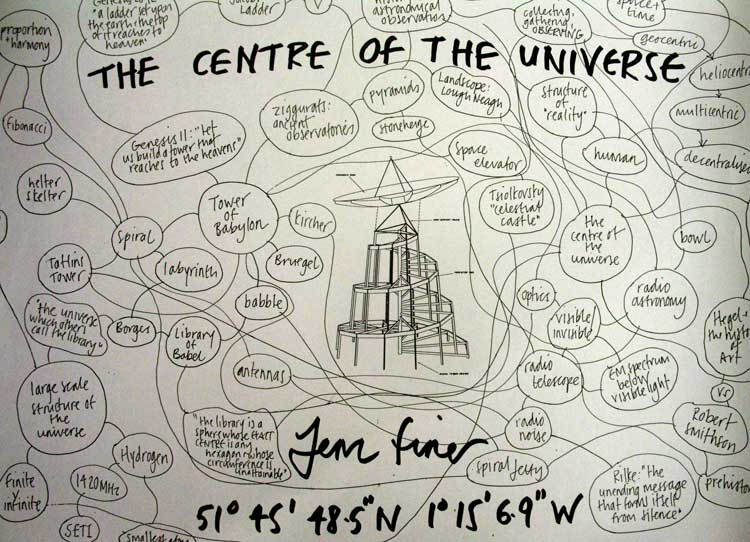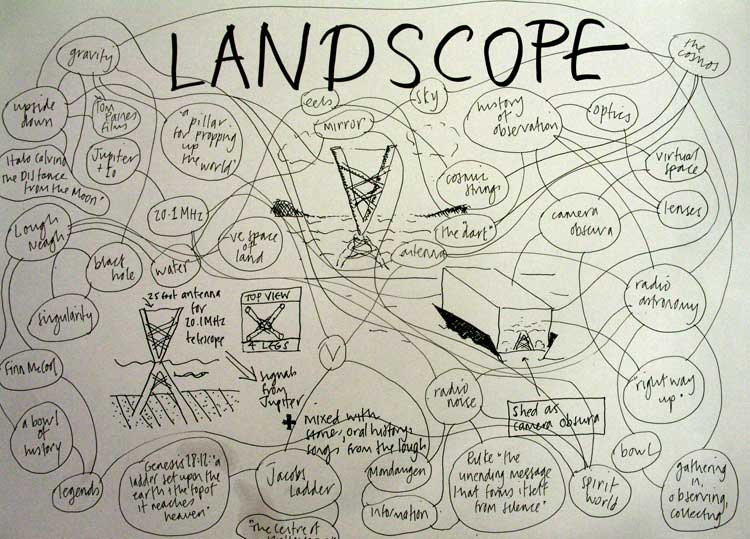February 20, 2005
nonsite
Sheds in gales sometimes land in peculiar places . . .


. . . inside . . .
February 19, 2005
thanks to . . .
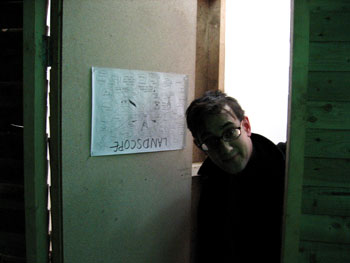
. . . Daniel Jewesbury and Paul Moore, without whom this would never have happened.

February 18, 2005
910 degrees
Regular readers will remember the robot (cosmolog, 6/2/2004). Its creator, Jorn Zehe came over to visit - and lend a hand - during the construction of Landscope. With him he bought another of his inventions, a camera that takes 910 degree panoramas. Here, then, is a QuickTime VR movie of the photo it took. As ever, this might fail to load on certain computers. QuickTime 6.2+ is required. If it does load you can rotate through the image with your mouse and (on a mac at least) zoom in with the shift key and out with the ctrl key.
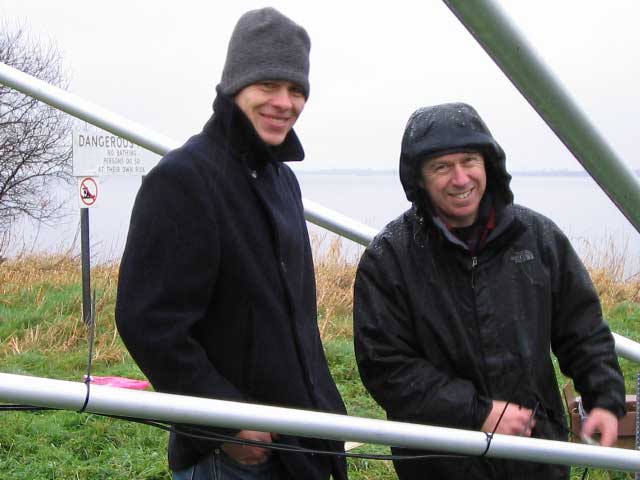
Jorn and Jem, an Artpal success story.
photo : Marcia Farquhar
February 14, 2005
a puff of smoke

We dismantled the shed and the mast, loaded them onto a lorry and left the lough.
The shed - and a record of its inner life at Lough Neagh - will be exhibited in the Ormeau Street Baths Gallery, Ormeau Street, Belfast from the 17th February until the 25th March as part of the Vis-onic Festival.
February 13, 2005
gone fishing

The shed held out, the mast finally fell. With its poles and lines it resembled an abstract fishing apparatus, apt for its location in a lough full of eels.
The parallels don't end there: like fishing, radio astronomy depends on making plans as best one can and then hoping to catch something. You lay out your lines, trimmed to the wavelength you're angling for and aligned to net the fishes trajectory through the sky. Your lines baited and hooked you wait for the appointed hour, the optimum feeding time, fishing the lough for radio storms. Maybe you'll catch nothing, maybe you'll catch the fish you expected. If you're very lucky though , you'll catch something you never knew existed.
This seems an analogy fitting the process of both the scientist and the artist: setting up initial conditions so as to create a situation in which something occurs, something unexpected, a discovery transcending expectations and explanations.
The scientist then seeks to explain, the artist leaves it as it is . . .
February 12, 2005
noise from jupiter
. . searching for a signal from Jupiter . . . .
click on image to play (you'll need at least Quicktime 6+)
gales from earth
The night vision camera obscura . . . the gale outside the shed drowning out the radio storm, while one of Pauls found recordings of local history rises above the din.
click on image to play (you'll need at least Quicktime 6+)
we're not in kansas anymore
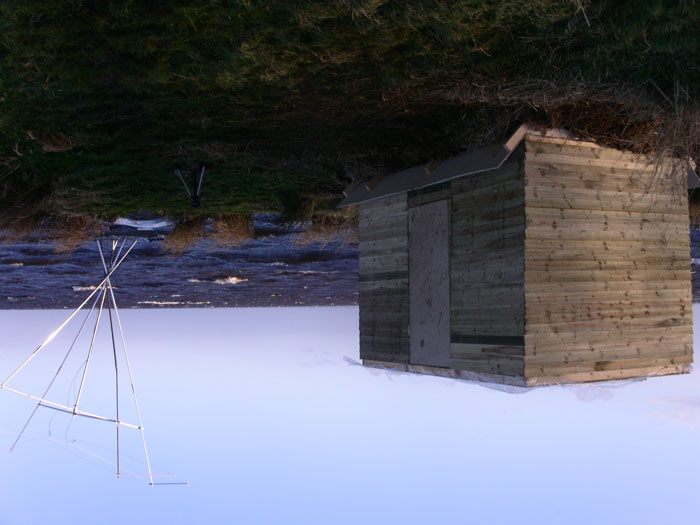
In the night the wind picked up. Gales were forecast and I woke several times thinking of the mast, listening to the wind rattling my windows.
When we arrived in the morning it was lying on its side, the lough now blown by the rising wind, a rougher body of water.
Daniel, Paul and I managed to push it back onto its base and floated it back into shallower water where we anchored it, building cairn like piles of rocks at each corner, until the wind blew and flexed the mast but the base stayed sound on the lough bed.
During the morning the wind rose more and blew squalls of horizontal rain, first from the west, then shifting to the north west and ominously towards the north. Installing the equipment in the shed was precarious, lining areas of wall with plastic to try and keep the electronics dry, moving equipment into the corners away from the leaks.
I hung a mic in the lough, cable tied to the base of the mast, set up the radio telescope receiver and plugged them into a mixer along with Pauls laptop full of stories. We cut a hole for the camera, the camera obscura "lens", to look out of and pointed the projector at the opposite wall.
The rising storm shook the shed. The upside down structure became more like Dorothys house in the twister, a hillbilly space craft, as the wind rattled the walls and strained the joints, blew through and round and under, looking for a chance to lift it, to get inside and tear it apart.
Through the afternoon people came and went, took shelter in the shed, watched the inverted pinholed world, listened to the stories of the lough, to the invisible worlds beneath its surface and streaming in from space.
In the night, illuminating the mast, it became two dimensional, a geometric diagram, a constructivist animation, bending and bowing in the wind. The horizontal rain was rendered as electron ghost tracks in a cloud chamber, tracing scratched lines across the night vision screen inside the shed. A floor board popped up as the shed strained and pulled and twisted.
The mast and the shed became part of the same vessel, connected now not only by their optical, conceptual and functional relationship, but by their being two halves of a whole separated in the storm, mast and cabin.
Like sailors fighting to keep a boat afloat in a gale, on wild seas, we bailed and braced the shed for hours. At 2.30 am, while listening to a radio storm from Jupiter, the terrestrial storm outside threatened to turn the shed over. With rain spilling through the walls we cleared out the equipment, jammed the door shut behind us and abandoned ship.
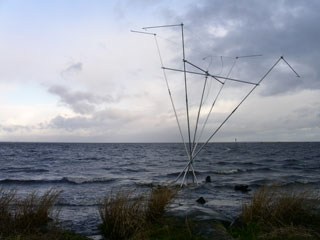
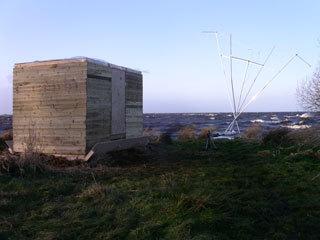
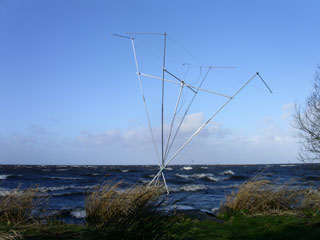
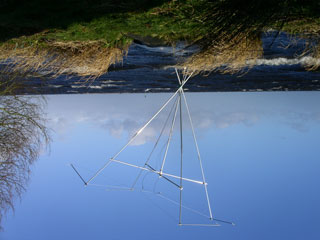
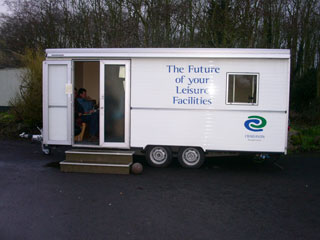
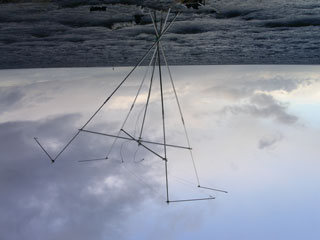
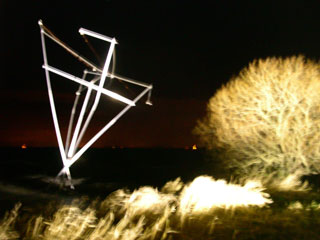
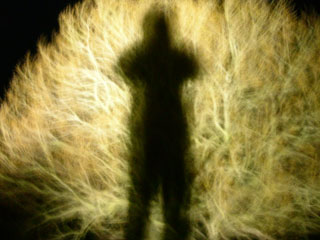
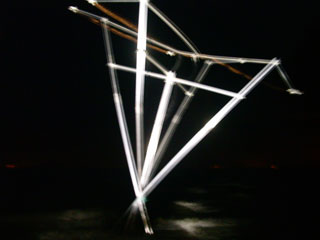
February 11, 2005
Landscope live stream
Landscope live stream : from 3pm GMT, Saturday 12th February - evening of Sunday 13th, there will be a live stream from Lough Neagh, N.Ireland :
http://formations.org.uk/finer.html
the antenna
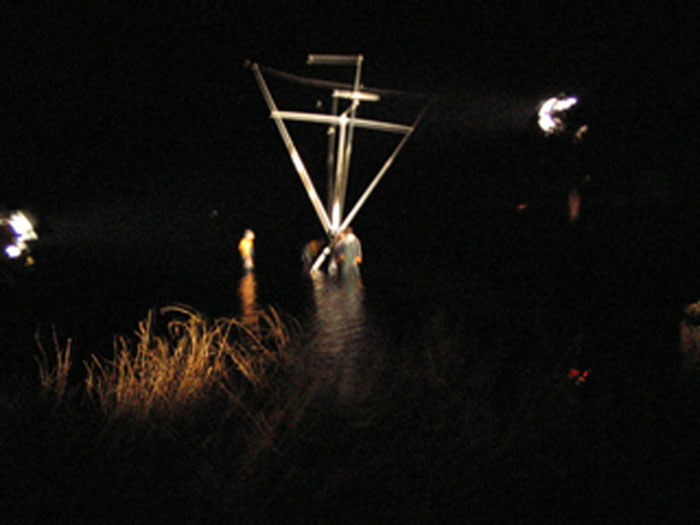
Landscope was built by myself, Daniel Jewesbury, Paul Moore, Mike Hogg and Nicky Keogh. Mike made most of the shed, while Daniel, Paul and myself assembled the antenna mast.
We built the mast on its side, bolting together the sections of aluminum tubing and rigging the antenna itself, two 23 and a half foot dipoles. The tricky bit was attaching it to its base, a cross made from 4 lengths of 4 by 2. Each of the arms of the cross were made from two lengths, between which the ends of the mast had to be bolted. Typically, we didn't have a drill bit long enough to go through two widths of timber and the mast, necessitating a trial and error approach, drilling in from both sides.
By the time we'd attached the base and lifted the mast to its upright position, night had fallen. The weather had cleared, the rain had finally stopped, the sporadic gusts of wind had died down and the lough, into which we had to carry the mast, was calm.
The attendant BBC crew had had the foresight to blag four dry suits for us to wear . . . all in one wellington boots and rubber overalls, black below the waist with yellow tops, trimmed with tight rubber collar and cuffs. The diagonal zips, from hip to opposite shoulder, leant the appearance of a retro future space man crossed with oil rig worker.
Taking a corner of the wooden frame each, and lifting, we slowly walked to the bank of the lough, now lit by the BBC, and carried it out into the water, into the ink black void of moonless Lough Neagh, step by careful step.
With its wooden frame base, it had begun to resemble a strange craft, a raft rigged for abstract purpose, to be launched on a journey into the unknown, flighted on the geometry of its inverted sails, the negative space of the masts poles.
Setting it down on the stony bed of the lough, it floated up, surprisingly buoyant, completing its metamorphosis into a vessel, ready to float beyond our reach, toward the horizon, where the lough melted into night.
While one man stood at the apex of the base, holding the mast, like a castaway, a voyager, we piled rocks on the wooden beams until it rested, anchored by their weight, on the lough bed.
Thanks to Marcia Farquhar for some of these images.
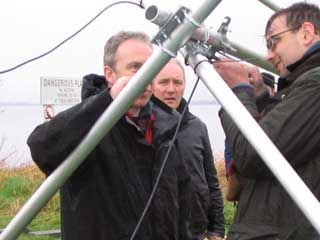
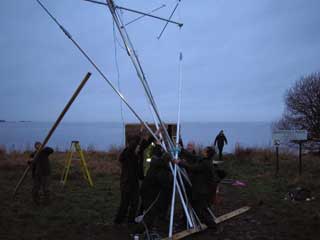
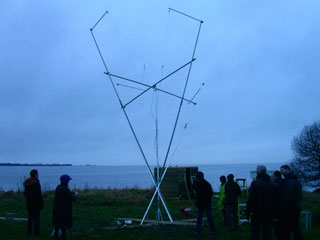
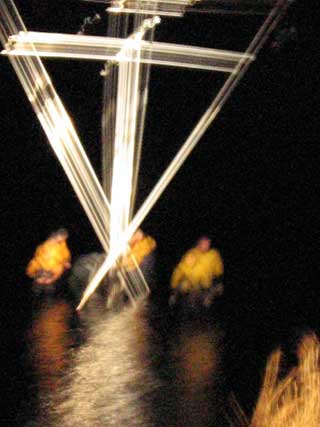
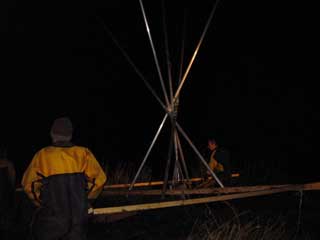

February 10, 2005
February 9, 2005
Aerialworld

Aerialworld is a beautiful world full of bits and pieces for making aerials with. The trouble is that most of them are not quite the right specification - too thin or too short or not arriving next monday. This is not Alans fault, it's mine for taking so long to figure out quite how to build the bloddy thing.
I have come to the conclusion that it's best to see if it's possible to make the antenna out of what is in stock, even if it means making it a bit smaller than originally planned. i.e. 30 feet high as opposed to 50 feet high, that kind of thing. After re jiggin dimensions, a lot of pythagoras, squaring and square rooting, converting feet to meters and back again, trying to find trucks that will fit the required lengths into them and a few more trips to Aerialworld, a solution is finally arrived at and all necessary pieces assembled, ready for pick up (fingers crossed) tomorrow morning.
We (myself, Mike, Daniel and Paul) will load it up into our van along with the prefabricated shed (which continues to take form) and head off to Lough Neagh with our waders.
February 8, 2005
shed and mast
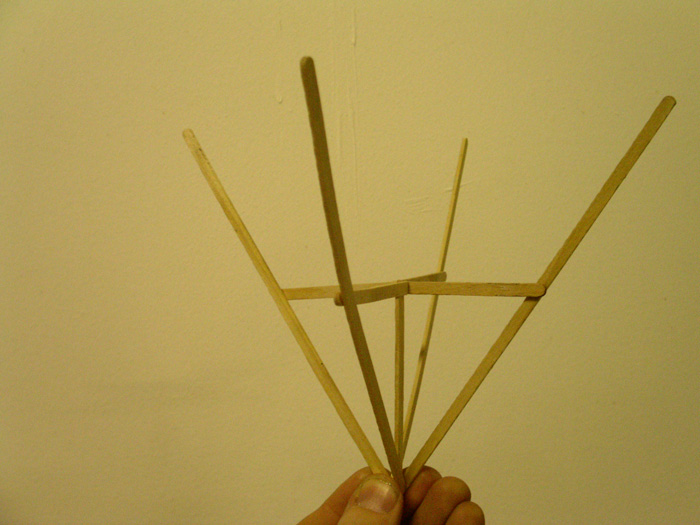
This is my idea for a new design for the antenna. The problem now is to get hold of the correct lengths of aluminium pipe to build it with. Between trips to Aerialworld the wood for the shed arrives and we begin to build it. Well . . . Mike Hogg at Flax starts to build it . . . very quickly ! . . . and I get to do the odd bit of sawing. I feel a bit like a kid trying to help with the cooking.
February 7, 2005
the superstore of babel
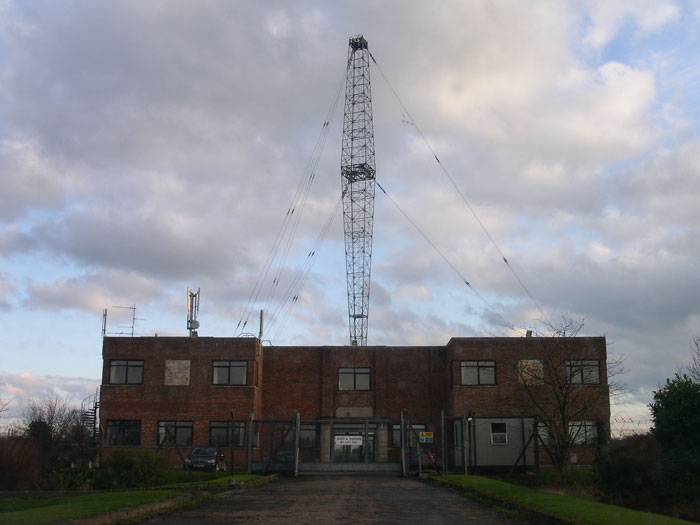
This day has been spent driving from pillar to post trying to find materials to make the antenna and shed for Landscope. An unfortunate series of administrative mishaps resulted in orders disappearing into thin air and led to a tour of Northern Irelands B & Q warehouses. I've never been in one before but there is something extraordinary about being in such a huge space in which (seemingly) every possible item of iron mongery, building, plumbing, DIY etc is on display. Like a living exhibit of all the catalogs in the world.
We wondered the miles of aisles browsing for possible materials to build the antenna. Wood, copper and plastic piping, industrial shelving, weird wire frames for use in plastering . . . all are up for grabs.
My original conceptions for how to build it have been discarded as impossible. I'm envious of the mast in the photograph. No one seems to know what it's for but it is very beautiful, balanced on its point and rising upwards and outwards . . . in a V, like the Landscope antenna.
At the end of the day the plan is to suspend the V from a horizontal H sitting on top of a tall I. I'm sure there is a better way to build it . . . maybe an X on top of an I . . .
